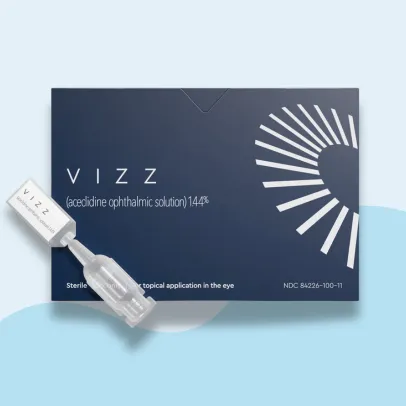The U.S. Food and Drug Administration (FDA) has approved a new type of prescription eye drops for age-related blurry vision, which could last long enough to get some people through an entire workday without reading glasses.
Vizz, the once-daily eye drops, are the first aceclidine-based solution to be approved for presbyopia, or age-related blurry vision, a condition that impacts 128 million adults nationwide, according to the drugmaker, Lenz Therapeutics.
 LENZ TherapeuticsSome healthcare providers may be able to provide patients with samples of Vizz starting this month, and the drops should be widely available by the end of this year, Lenz said in a statement.
LENZ TherapeuticsSome healthcare providers may be able to provide patients with samples of Vizz starting this month, and the drops should be widely available by the end of this year, Lenz said in a statement.
[1]
“Originally, the only treatment for age-related difficulty reading was eyeglasses or holding the book further away from your face,” says Daniel Diamond, OD, an assistant professor of optometric science at the Columbia University Vagelos College of Physicians and Surgeons in New York City.
“Eye drops to help with presbyopia have come into the mainstream in the past few years,” Dr. Diamond says. “Drops are of course a good option for people who either cannot use glasses or contact lenses, or who don’t want to be burdened by needing separate pairs for distance and reading correction.”
How Vizz Eye Drops Make It Easier to See Things Up Close
Aceclidine, the active ingredient in Vizz eye drops, works by causing muscles in the iris to contract, increasing the eye’s depth of focus, according to Lenz.
The FDA approval was based on two late-stage clinical trials with a total of almost 700 participants, per Lenz. People with presbyopia were randomly assigned to use Vizz drops or placebo drops once a day.
In these trials, Vizz improved near vision within 30 minutes and continued to have this effect for up to 10 hours, according to Lenz.
There were no serious side effects related to treatment. The most common issues were temporary and included eye irritation, dim vision, and headaches, according to Lenz.
How Vizz Compares With Other Eye Drops for Blurry Vision
Two older FDA-approved eye drops for presbyopia, Vuity and Qlosi, both contain the active ingredient pilocarpine hydrochloride. Similar to the main ingredient in Vizz, pilocarpine hydrochloride works by helping muscles in the eye contract.
Vuity is approved for use once or twice daily, but may not last as long as Vizz. In a late-stage clinical trial testing the twice-daily administration, Vuity improved near vision for up to nine hours, according to the drugmaker, AbbVie.
[2]
Qlosi can work for up to eight hours, according to drugmaker Orasis Pharmaceuticals.
[3]
“From a patient perspective, Vizz lasts longer and results in a smaller pupil, providing better near vision than previous generation medications,” says Eric Donnenfeld, MD, a clinical professor of ophthalmology at New York University in New York City.
Downsides to Using Eye Drops as a Fix for Blurry Vision
One downside to Vizz and the other FDA-approved eye drops for presbyopia is that they all have a limited period of effectiveness, says Sidney Gicheru, MD, an ophthalmologist based in Dallas, who’s a clinical spokesperson for the American Academy of Ophthalmology
“The drops are FDA-approved as a once-a-day medication,” Dr. Gicheru says. “However, prospective users should be aware that the prescribing information suggests the duration of action is shorter than a full day.”
Additionally, “People who drive at night or in the dark frequently should be cautioned that the drops cause pupillary constriction, which can affect night vision,” Gicheru says.
Are Eye Drops a Better Choice Than Other Vision Correctives?
Because there are multiple ways to correct presbyopia — including glasses, contact lenses, and vision correction surgery — the decision to choose eye drops will come down to a personal choice, Diamond says.
It may also depend on what type of insurance coverage people have for glasses and contact lenses, which varies widely, and how this cost compares with the out-of-pocket expense for prescription eye drops. Vizz may cost around $80 a month with insurance, Donnenfeld says.
“I see tons of patients every week in their early forties who are starting to have difficulty with reading, and the vast majority do very well with reading glasses,” Diamond says. “But there definitely are patients who never had to wear glasses before, or do not like how glasses look or feel, and for these patients the drops are going to be a game changer.”

